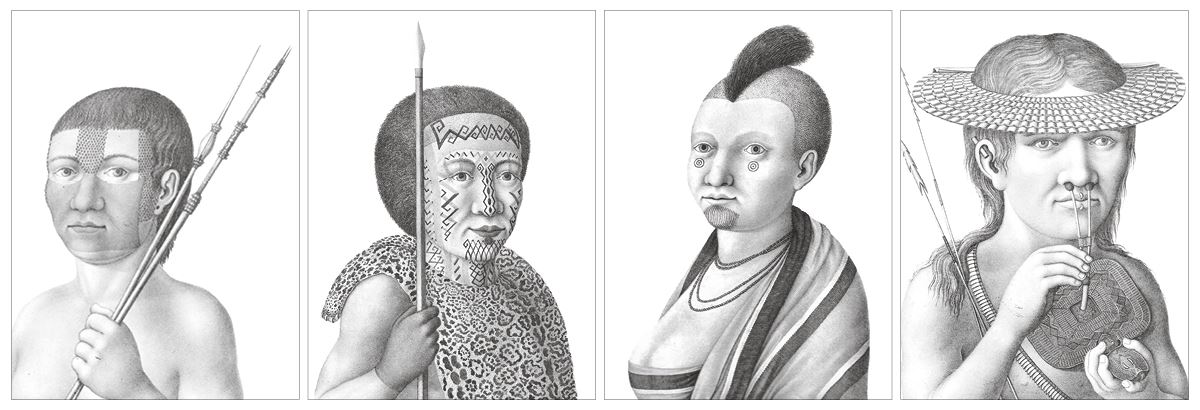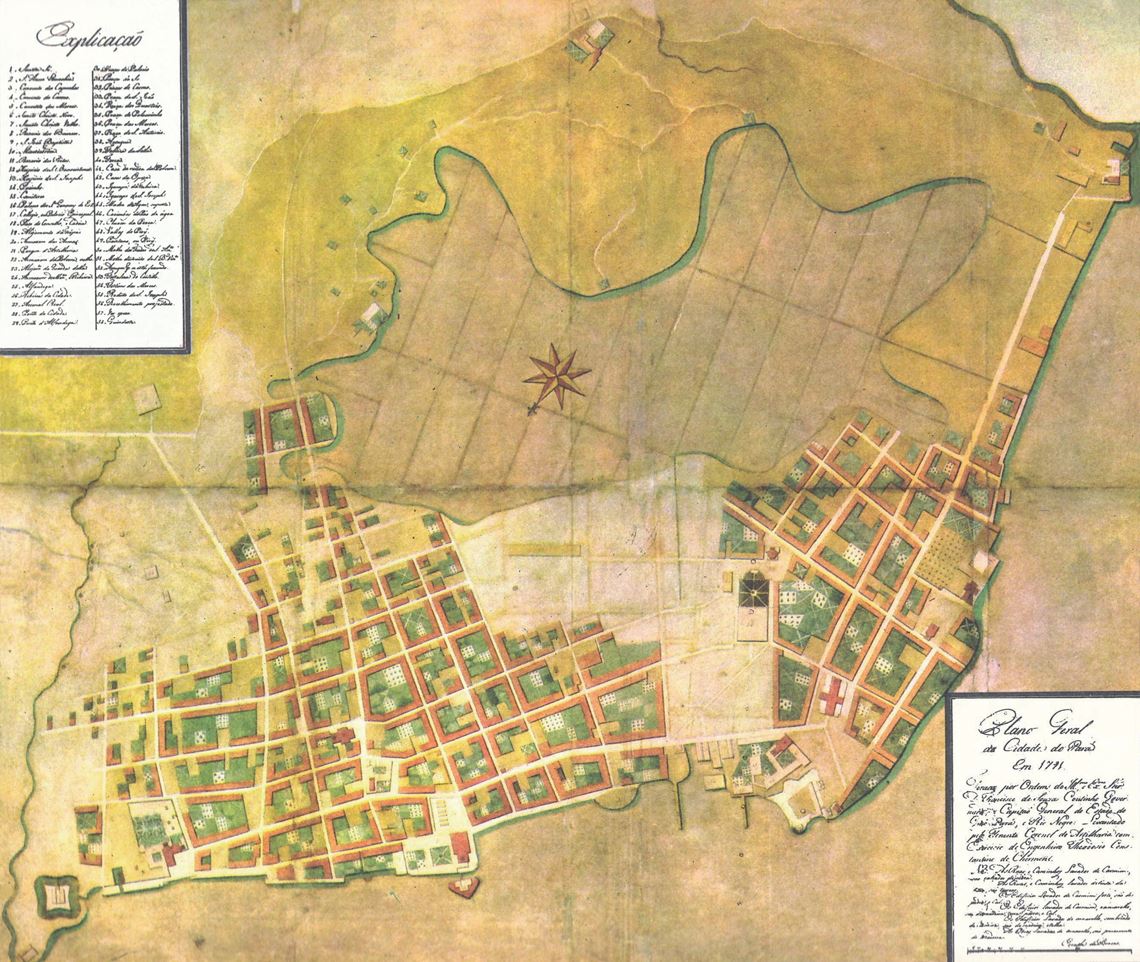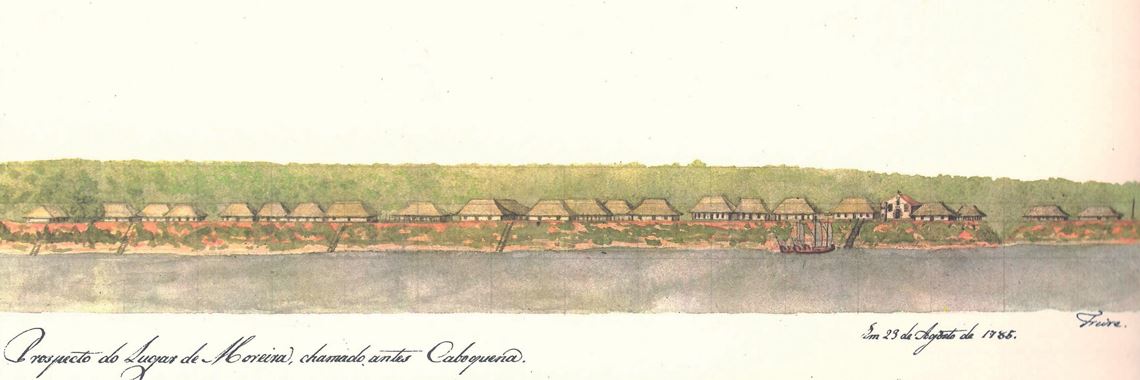The existence of connections between Brazil and Africa in the colonial period is a recurring theme in historical studies dedicated to investigating economic and social factors related to the slave trade. Slave trafficking, however, was not the only factor responsible for creating bridges among territories explored by the Portuguese. According to historians who discussed the topic in a virtual seminar held in February, healing techniques and knowledge about fauna and flora circulated among different regions of the Portuguese Empire, mainly through the use of medical treatises, as well as via topographic maps produced during the sixteenth and eighteenth centuries. The consequences of the interactions between urban authorities, naturalists, and the keepers of local knowledge are the subject of recent studies, which seek to understand how this relationship—marked simultaneously by conflicts and cooperation—has impacted European culture and created conditions for the use of science as an instrument of power.
The competition between European empires for dominion in Africa, India, and Brazil caused the Portuguese Crown to invest in so-called “philosophical voyages,” explains Brazilian historian Gisele Cristina da Conceição. “Coordinated by Italian naturalist Domenico Vandelli [1735–1816], these expeditions aimed to develop a natural history of colonial dominions, in order to identify the economic potential of their natural resources, and to find suitable soil for the cultivation of plants from other continents.” Consequently, such expeditions contributed to consolidating, in Portugal, natural history studies that recast what was known about the New World up to that time.
The contact with traditional knowledge regarding the use of plants, animals, and goods that served as currency for local commerce paved the way for the establishment of commercial warehouses in Brazil, Africa, and Asia. “During these voyages, Europeans faced difficulties in adapting, and were repeatedly infected by tropical diseases. It was common to make use of the local wisdom to find possible treatments,” says Conceição, who concluded a postdoctoral internship in December at the School of Philosophy, Languages and Literature, and Humanities at the University of São Paulo (FFLCH-USP), with support from FAPESP.
In her research, Conceição found references to the healing arts practiced in the kingdom of Angola in medical manuals that were circulating through Europe during the eighteenth century. “The knowledge produced by the Portuguese in Angolan territory was developed based on observation, incorporation, and reconfiguration of locally generated botanical knowledge and practice.” One of the works the historian analyzed was A árvore da vida (The tree of life), published in 1731 by Portuguese military officer Francisco de Buytrago. “He worked in Angola for two decades and decided to write a medical guide after returning to Lisbon.”

Domenico Vandelli / Wikimedia Commons
In 1788, Domenico Vandelli of Italy published his Dicionário de termos técnicos da história natural, with depictions of plant species encountered during “philosophical journeys” made in dominions of the Portuguese EmpireDomenico Vandelli / Wikimedia CommonsBuytrago’s objective, says Conceição, was to provide relevant information about common diseases in Angola and how they could be cured using medicinal plants and herbs. “By cataloging diseases and plant species, Buytrago produced a cross-cultural work,” the researcher says. “The book isn’t a simple attempt to disseminate medical knowledge from Angola, but the result of an encounter between different cultures. These ‘contact zones’ were able to generate new knowledge that, in turn, cannot be understood as purely European.”
According to Conceição, the studies produced in the colonies usually moved throughout the entire empire. Knowledge that originated in Brazil regarding the use of plants for medical purposes was influential in Angola. “Doctors and plants circulated extensively among the colonies, and this helped to strengthen the ties between them.” This exchange of information, however, had as a backdrop the concern about the debilitating diseases that could affect captives being deported from Africa to the Americas.
“That’s why having access to medical knowledge about common diseases in Brazil was essential for traffickers and slave owners, since the deaths of blacks represented a decrease in their workforce and profits,” she observes. Conceição was an organizer of the online seminar “Producing, accumulating, and transmitting knowledge in the Portuguese Empire: Practices and objectives (during the sixteenth to nineteenth centuries),” conducted in early February by the Historical Cartography Research Lab of the Jaime Cortesão Chair, linked to FFLCH-USP.
“The history of science during the colonial period has seen increased focus over the last decade,” notes historian Íris Kantor, a professor at the History Department of FFLCH-USP, who was also one of the event organizers. In her estimation, contemporary approaches seek to reconstruct the complexities of both the production and the transmission of knowledge useful to the colonization and evangelization of populations under Portuguese control. “This was knowledge generated within the networks of mercantile exchanges, and in the interactions engendered by missionaries and military confrontations.”

Public Domain / National Archive Collection
Illustrations of different indigenous peoples produced during expeditions led by Bahian naturalist Alexandre Ferreira from 1783 to 1792: 1 and 2 Jurupixuna, 3 Guaicuru and 4 MuraPublic Domain / National Archive CollectionIn Kantor’s view, the knowledge acquired during cartographic expeditions and philosophical voyages made it possible to carry out the territorial occupation and military defense of the Portuguese dominions during the era of independence of the 13 English colonies and the Napoleonic expansion. “Maps and population censuses prepared by cartographers and naturalists also assisted with the forced displacement and resettlement of indigenous populations, especially after the treaties with the Spanish Empire between 1750 and 1777.”
The data resulting from these expeditions contributed to the drafting of the Indians Directorates, enacted in 1755, which transformed indigenous villages—hitherto administered by missionaries—into self-governing municipal villages administered by indigenous leaders and civil-society directors. The new law aimed to integrate native peoples into military troops, populate border regions, and guarantee the supply of labor for agriculture, fortress building, and transporting goods (see Pesquisa FAPESP issue no. 249).
“In this context, describing and representing the observed reality both verbally and graphically was central to the accumulation of scientific information during the colonial period,” emphasizes Kantor. Kantor believes that the expeditions created cultural habits that permitted the subordination of indigenous peoples, “to the extent that the interactions were not symmetrical and didn’t provide for the full development of the local communities, despite the Enlightenment rhetoric.”
However, unlike Spain, Portugal promoted the intellectual training of naturalists, military engineers, doctors, and natural magistrates from South America, granting scholarships in institutions such as the University of Coimbra, and jobs in public administration. Upon returning to Brazil, these men—descendants of European elites—were engaged to join the philosophical and cartographic expeditions. They therefore remained at the service of the Crown, assuming management positions and producing botanical, geological, and demographic data and information.
At the same time, Portugal hindered the establishment of science academies in Brazil and prevented the publication of research, including prohibiting the operation of printers, which only became legal in 1808, with the transfer of the empire’s headquarters to Brazil. “The scientific knowledge generated in the colonial dominions was treated as a confidential matter, which was to be limited to the scientific institutions of the metropolis,” says Kantor.

Public Domain / National Archive Collection
During Ferreira’s travels, various cities were mapped, among them Belém…Public Domain / National Archive CollectionIn some cases, the knowledge generated by these expeditions didn’t even circulate within the empire itself. Such was the case of texts written during the philosophical voyage led by Bahian naturalist Alexandre Rodrigues Ferreira (1756–1815). He and his expedition covered more than 39,000 kilometers over a nearly 10-year period, traveling through the captaincies of Grão-Pará, São José do Rio Negro, and Mato Grosso. Along the way, they collected and made drawings of plants, animals, and fossils. They also mapped the course of several rivers and produced visual documentation on the material culture and customs of the populations found along the route between Belém and Cuiabá.
The results of the expedition, however, were not released in European scientific journals, as would be expected. “The documentation sent to Portugal during the trip was disorganized and boxed up for many years,” explains historian Breno Ferraz Leal Ferreira, who analyzed the naturalist’s work during his postdoctoral internship at the Institute of Philosophy and Human Sciences at the University of Campinas (IFCH-UNICAMP). “It only began to be published in the 1940s, within a completely different context. Part of the collection of nature samples sent to Lisbon was confiscated by the French during the Napoleonic occupation of Portugal beginning in 1807 and taken to French scientific institutions and museums.”
Most of the reports made by Alexandre Ferreira remain in their handwritten, untranscribed form to this day. In his text “Observações gerais e particulares sobre a classe dos mamíferos” (General and particular observations on the class of mammals) (1790), the naturalist recognizes indigenous people as belonging to the species Homo sapiens—using the modern scientific classification proposed in the eighteenth century by Swedish taxonomist Carl Lineu (1707–1778). It was a matter of attributing modern and scientific “clothing,” in accordance with contemporary standards, to an older point of view, one which already ranked the indigenous to a subordinate condition. “Alexandre Ferreira argued that indigenous peoples were an ‘inferior’ form of Homo sapiens when compared to Europeans,” the historian says.
Although he considered that the natives were in a primitive stage of development, or in their “societal infancy,” Alexandre Ferreira recognized the importance of indigenous people in obtaining information about natural resources and their possible economic, medical, and dietary uses. In his writings, the Bahian naturalist even mentions the names of two indigenous individuals, Cipriano de Souza and José da Silva, who helped to prepare plant samples “with skill” and hence were promoted to ensign, an erstwhile military position.
Conceição draws attention to the need to highlight the complexity involved in the construction of knowledge. As a reference, the researcher cites French historian Kapil Raj, from the School of Advanced Studies in the Social Sciences (EHESS), in Paris. “According to Raj, science is not the result of a linear and unified process of knowledge, but a system affected by historical aspects related to the cultural identity of its producers, and their social practices, political circumstances, and cognitive skills.”
For Portuguese historian Amélia Polónia, from the Department of History, Political and International Studies at the University of Porto, the dominant historical narrative written by Europeans concealed individuals and groups that contributed to the evolution of science. She highlights the role of women in the dissemination of knowledge during the Portuguese Empire. “In general, Portuguese and native women acted as intermediaries between the worlds of the metropolis and the colonies, integrating informal, self-organized networks that made knowledge circulate.”
As an example, Polónia cites the issue of childbirth. “In 1567, ecclesiastical resolutions prohibited the presence of non-Catholic women at the deliveries of Catholic women. In practice, however, many Christians gave birth with the help of midwives who possessed knowledge gained from Asian societies.” At the same time, says Polónia, there are reports of Portuguese women who served as midwives in India and learned local techniques, which were later applied in Europe. “Abortion methods based on popular knowledge from places like India and China have also influenced new approaches in the Western world.”
The construction of new knowledge in Europe often took place through the reconfiguration of traditional knowledge that was produced in the colonies, notes Brazilian historian Fabiano Bracht, a researcher at the University of Porto. “Talking about circulation doesn’t mean thinking only about the dissemination or transmission of ideas. It’s a matter of understanding how local production is reconfigured based on the struggles to control certain knowledge and obtain benefits from it,” he says. Bracht is author of the book Ao ritmo das monções: Medicina, farmácia, filosofia natural e produção de conhecimento na Índia portuguesa do século XVIII [To the rhythm of the monsoons: Medicine, pharmacy, natural philosophy, and knowledge production in 18th century Portuguese India] (Edições Afrontamento, 2019).
An example of reconfiguring knowledge is the book Simplices sinicos medicinaes (Oriental plant medicine), by the Jesuit priest António de Barros (1717–1759). The work is actually a Portuguese version of a document called Ý Haoc, a Vietnamese term for “medicine.” Barros worked as an ambassador for Portuguese missions in Goa, India, Macau, and Beijing, China. “It’s likely that he was chosen because he had advanced knowledge in a few Asian languages, including Mandarin, the official language of the Chinese court and state bureaucracy.”
Barros’s manuscript is much more than a simple translation, Bracht points out. “It presents more than 500 medicinal herbs, not only according to the principles of Eastern medicine, but also seeks out relationships with what was already known about the plants in Europe.” This is the case of the false acacia (Robinia pseudoacacia), a plant from North America introduced in Europe in the seventeenth century and, in Asia, in the eighteenth century. The botanical genus Acácia comprises 163 species, 52 native to the Americas, and 83 African, 32 Asian and 9 Australian species. “Most species have thorns, yellow flowers, and pungent roots. Because they are legumes, they all produce pods. Acacias have been known for their medicinal properties in Europe, America, Africa, and Asia from time immemorial,” observes Bracht.
“What Barros did was to identify similarities between the plants, taking into account the Galenic classification system based on ‘subjective’ properties, such as hot, cold, dry, and humid,” says Bracht. Thus, without taking into account morphological or chemical aspects (which were not yet elements of the science of that time), but rather the effects of plants in the treatment of diseases, Barros considered that a plant known by the Vietnamese as Huinh cám could be a false acacia, classifying it as having “hot” properties and suitable for the treatment of bladder diseases, derived from “cold” causes.
Another case of the circulation and reconfiguration of knowledge in the Portuguese Empire is the work on medicinal plants published by Bahian military officer Domingos Alves Branco Muniz Barreto (1748–1831) at the end of the eighteenth century, which was based on indigenous knowledge. “His survey is interesting because it doesn’t hide his interaction with the indigenous populations. On the contrary, Muniz Barreto makes it clear that it was through cultural exchanges that he constructed his own knowledge about the local vegetation,” adds Conceição.
She believes the presence of both European and indigenous cultures can be observed in Barreto’s writings. “At the same time that he mentions Lineu’s work, for example, he also mentions the knowledge of an indigenous person regarding a certain herb.” Muniz Barreto’s work reached Portugal through his contacts at the Lisbon Academy of Sciences and other influential people linked to the reigning powers.
For Kantor, at USP, research on the processes of building networks for transmitting and accumulating scientific knowledge during the colonial period can aid in understanding current challenges faced by nations coming out of the colonial experience. “The culture of collecting, observing, and statistically representing scientific information distinguished the generation of men who demanded and defended the idea of an emancipated Brazilian state, beginning in 1822. Not coincidentally, they knew that the exercise of political sovereignty depended on the creation of autonomous scientific institutions.”
Projects
1. Angolan medicine: The circulation, construction, and reconfiguration of medical knowledge in Angola in the first half of the eighteenth century (no. 18/11552-8); Grant Mechanism Postdoctoral Grant; Principal Investigator Iris Kantor (USP); Grant Beneficiary Gisele Cristina da Conceição Bracht; Investment R$218,876.63.
2. Eastern medicine: Construction, circulation, and reconfiguration of medical and pharmaceutical knowledge in Macau during the seventeenth and eighteenth centuries (no. 18/02259-5); Grant Mechanism Postdoctoral Grant; Principal Investigator Iris Kantor (USP); Grant Beneficiary Fabiano Bracht; Investment R$161,702.38.
3. The great chain of being: The animal kingdom as seen by Portuguese and Portuguese-American traveling naturalists (1772–1818) (no. 16/23264-1); Grant Mechanism Postdoctoral Grant; Principal Investigator Leila Mezan Algranti (UNICAMP); Grant Beneficiary Breno Ferraz Leal Ferreira; Investment R$749,694.74.

